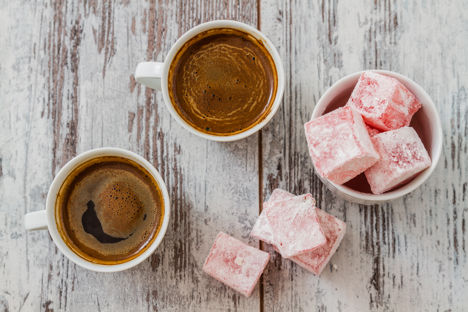
Turkish coffee: the beginner’s handbook
This thick, intense style of coffee is beloved throughout the Middle East and parts of Europe. But what is it, where did it come from and what do you need to make it? Read on to discover the secret pleasure of coffee aficionados the world over.
Turkish coffee: the beginner’s handbook
This thick, intense style of coffee is beloved throughout the Middle East and parts of Europe. But what is it, where did it come from and what do you need to make it? Read on to discover the secret pleasure of coffee aficionados the world over.
Coffee is big in Turkey. It’s a drink that’s become ingrained into the daily culture of the country – kahvalti, the Turkish word for breakfast, literally translates to ‘before coffee’ while the word for brown, kahverengi, means ‘the colour of coffee’. An impressive feat for a drink that only arrived in the Ottoman Empire in the fifteenth century.
Turkish coffee doesn’t refer to a specific type of bean, but the way in which the drink is prepared. Rather than using the more common European method, the beans are ground down into a fine powder with a pestle and mortar or (more commonly) a special Turkish coffee grinder, which can break them down into tiny, flour-like particles. These are then added to a copper pot called a cezve (or ibrik) along with the preferred amount of sugar; sade (no sugar), az şekerli (half a teaspoon), orta şekerli (a teaspoon) or çok şekerli (one to two teaspoons). The sugar is added beforehand as once the coffee is poured, stirring it would disturb the grounds at the bottom of the cup.
While the actual brewing process for Turkish coffee sounds simple, there’s a real art to producing the perfect cup. Water is added to the cezve and put over a medium heat until it begins to simmer. The liquid then begins to foam, at which point it is briefly taken off the heat and stirred. This step is repeated several times until the liquid has become thick, almost syrupy, at which point the pot is left to rest for a few minutes until the grounds have settled at the bottom. The coffee is then carefully poured into small demitasse cups, much like espresso, leaving as many of the grounds as possible in the cezve. The resulting drink is much more intense than other types of coffee, with an almost chewy texture thanks to the way it’s made.
The cezve
While you could technically make Turkish coffee in any old pan, the cezve isn’t just used because it looks nice. Made of brass or copper – two metals known to remove impurities and conduct heat – its narrow neck means the coffee will begin to foam more quickly while simmering. A wider base provides more contact with the heat source, while the handle and spout make pouring the coffee as easy as possible.
The grinder
You can make Turkish coffee at home using shop-bought grounds, but as with all good coffee it’s best if you can grind your own. However, most electrical burr grinders (a machine that’s the industry standard for grinding coffee and produces less heat than blade-based grinders, sort of like a more powerful pepper mill) cannot achieve the powdery consistency needed for Turkish coffee.
That’s why Turkish coffee grinders fall into their own unique category, with a special burr mechanism (essentially two rotating abrasive surfaces that pulverize the coffee beans into a fine powder) ideal for this method of brewing. As well as looking the part (most are made from the same materials as the cezve), they’re almost always made to an incredibly high standard, so they’ll last you for decades, and there’s something quite satisfying about manually grinding your beans by hand.
Drinking Turkish coffee
In Turkey, the actual act of drinking the coffee that’s been so carefully brewed (it can take up to ten minutes to properly prepare a cezve of coffee the right way) can be just as important as the process. Despite the small cups Turkish coffee is served in, it’s not there to be downed like a shot of espresso; the rich, intense flavour means it should be sipped slowly over a conversation. And while sugar can be added to counteract the bitterness, a sweet (known as a lokum) such as Turkish Delight or baklava is usually served alongside a cup of unsweetened coffee. Likewise, spices such as cardamom, cinnamon and star anise can be added before brewing to add even more flavour. Finally, the sediment left in the bottom of a cup of Turkish coffee can be used to tell fortunes, although you should never try and interpret your own cup!


